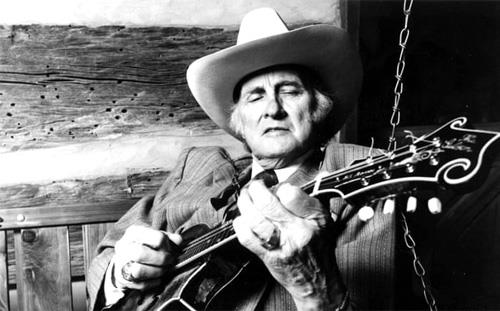
It was supposed to be regional music, rural music. Then bluegrass spread way beyond that.
Big Family: The Story of Bluegrass Music, on PBS August 30 at 9 p.m. ET (check local listings), starts by quoting Bill Monroe (top), a pioneer of the sound: "Bluegrass has brought more people together and made more friends than any other music in the world."
Then it shows that impact.
We hear Monroe's Blue Moon of Kentucky on his own 1947 record and on the flip side of Elvis Presley's first record (That's All Right Mama) in 1954. And from a modern Japanese group.
It so happens that Japan likes bluegrass music.
"They treated us like the Beatles," says Jeff Hanna of the Nitty Gritty Dirt Band.
Bluegrass is a sound that grew in the hills and hollers, but its stars now come from all over. Stars such as Alison Brown who is a Harvard grad with a UCLA MBA, or Laurie Lewis and Alison Krauss who are both from college towns (Berkeley, CA and Champagne, IL). "I fell in love with bluegrass music when I was a teenager," Lewis says.
Others include Chris Thile, who hosts the spin-off of A Prairie Home Companion, Live From Here, and is from the San Diego area. Béla Fleck, the banjo master, is from New York City. His first impression of bluegrass vocals: "It sounded like cats being slaughtered," he says. "That probably wasn't a smart thing for a Yankee to say."
The music was sort of meant to sound like that and was dubbed "the high, lonesome sound."
It started with immigrants from Scotland, Ireland, and beyond. They brought portable instruments and, Ricky Skaggs says, "their broken hearts from leaving their families."
So the mournful sound – in vocals, fiddles, and more – was logical. Soon, texture was added.
Near Monroe's Kentucky home, the film says, the best musician was a black blues guitarist, Arnold Shultz. In a time and place that rarely saw the races together, music was an exception. Schultz is "widely credited with putting the blues in bluegrass," says Rex Ellis of the Smithsonian Institution.
More influences came when Monroe moved north. He was 10 when his mother died, 17 when his father died, and the following year he began working in a steel mill near Chicago and sampled the city's music. "That's where Bill really came across hillbilly music," says historian Neil Rosenberg.
After a couple of other bands, he formed the Blue Grass Boys in 1938 and reached WSM's Grand Ole Opry the next year. It was a perfect fit; he even joked that WSM stood for William Smith Monroe. (Oddly, it was named for the slogan of the insurance company that owned it, "We Shield Millions.")
The name Blue Grass Boys was simply a nod to Monroe's home state of Kentucky. But as others began to copy the sound, "bluegrass" became a genre.
There were plenty of spin-offs. Over the decades, more than 150 people were Blue Grass Boys; some – including Lester Flatt and Earl Scruggs – became greats on their own.
And there were copies. At first, Ralph Stanley replicated the style so meticulously that Monroe refused to be on the same record label.
But bluegrass kept making key additions, including:
New instruments, especially the Dobro resonator guitar. "There's a Dobro player in practically every big band we see," said Douglas, the instrument's biggest star. "And they're so good. It's amazing."
Women. Brown, a banjo whiz, remembers being a teen star in the late '70s. "People would say. 'You pick good for a girl.' " Now there are plenty of female stars and all-woman bands.
New generations. Now bluegrass is taught in colleges and played by hip-looking youths. By comparison, Monroe was a gracious host to The New South during a festival, the film says, but the next year he told his people not to book any "long-haired" bands.
Faster tempos. Monroe started that trend with his mandolin playing, but others keep accelerating.
Added layers. Darol Anger, who teaches bluegrass at Berklee College of Music, seems to invoke the "wall of sound" of rock's Phil Spector. He describes "a huge, powerful sound" and "this incredible wash of sound."
Bluegrass keeps growing; Thile describes an "explosive creativity." Adds singer/songwriter Jim Lauderdale, "The level of musicianship these days is mindblowing...The future of bluegrass is in good hands."